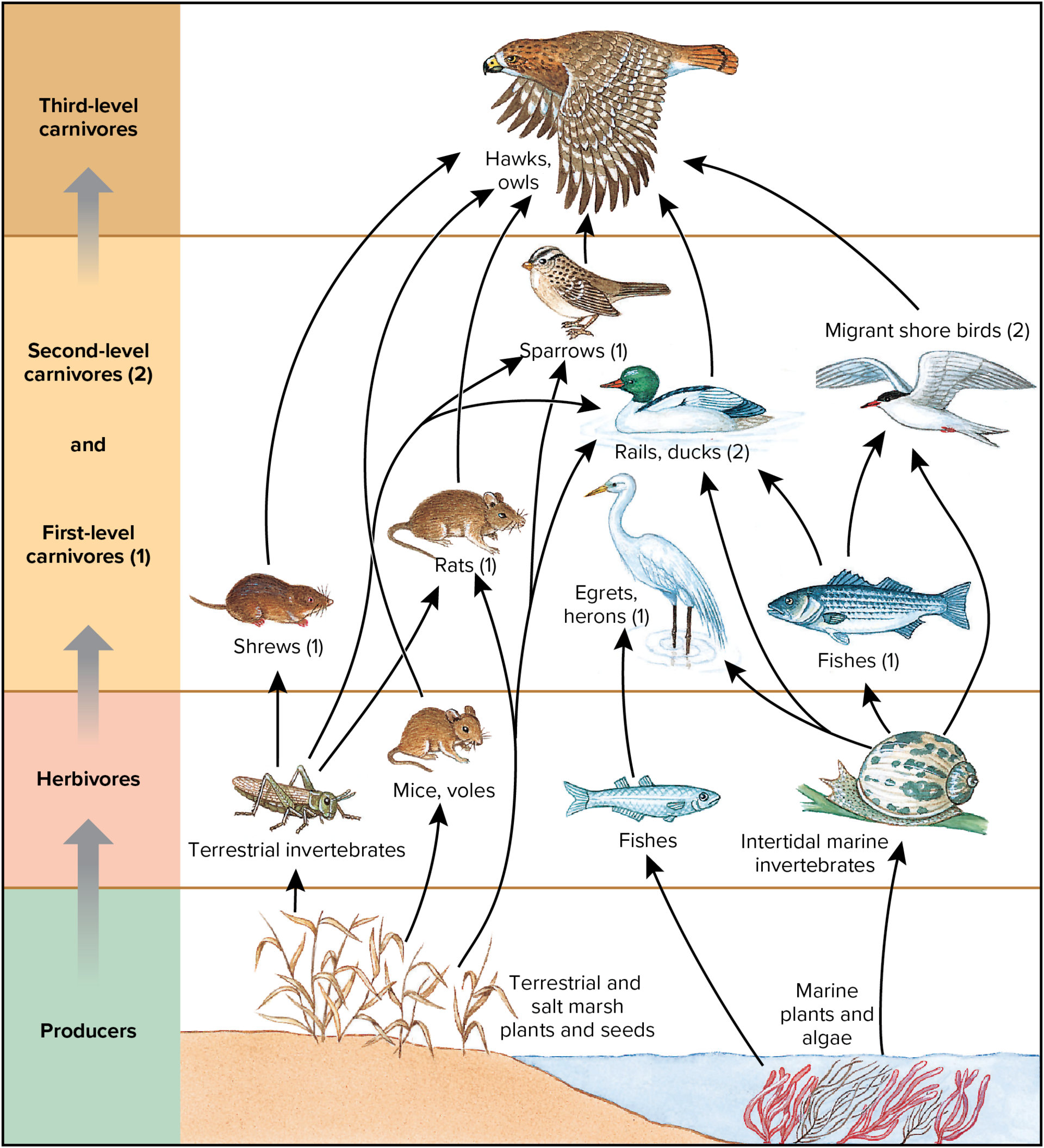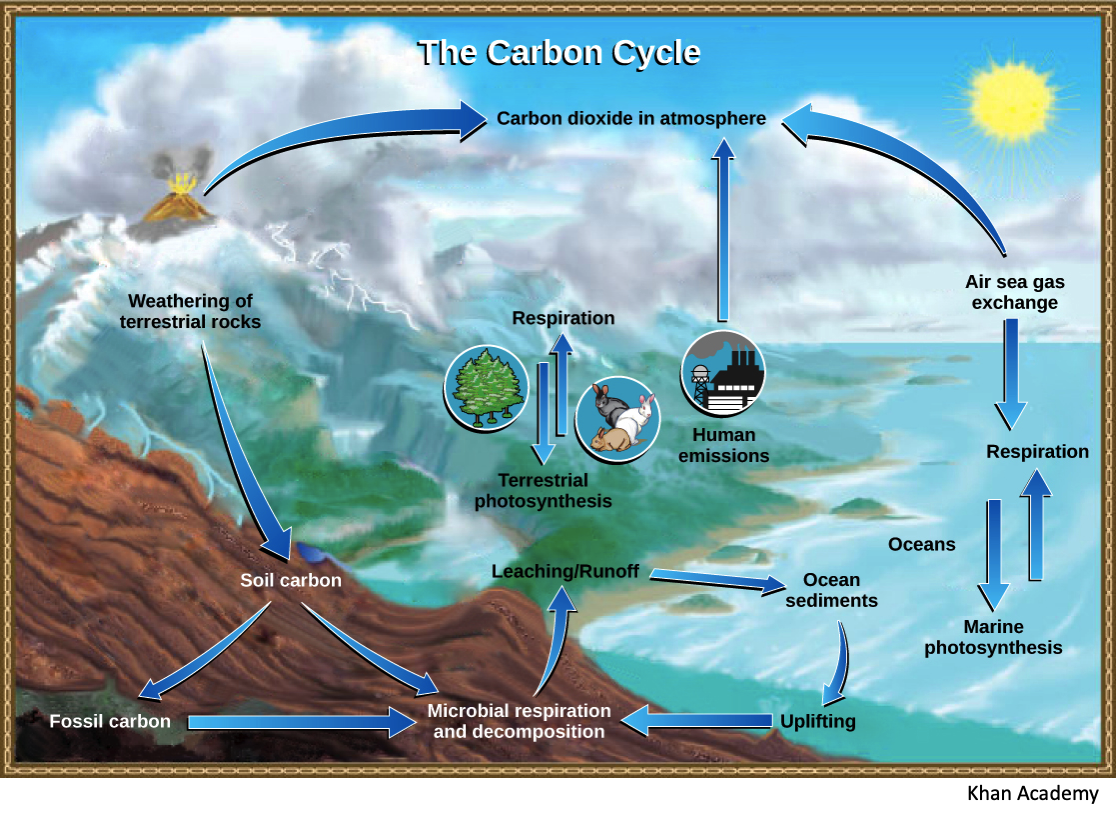Chapter 2: Animal Ecology
Ecology: The relation of the animal to its organic as well as inorganic environment.
Introduced by Ernst Haeckel (German zoologist) in the mid-19th century

<<Environment and the Niche<<
An animal’s environment comprises all conditions that directly affect its chances for survival and reproduction.
Conditions/factors:
- Abiotic
- Space (habitat)
- Forms of energy (sunlight, heat, wind, and water currents)
- Materials (soil, air, water, chemicals)
- Biotic
- Other organisms
- Prey, predators, competitors, hosts, mutualists, parasites
Niche
- The role of an organism, population, or species in an ecological community
- Components:
- Resource usage
- Unique way of life
- Relationship to other abiotic and biotic factors
- Subject to evolution by natural selection
- Undergoes changes over successive generations
1. Fundamental Niche
- Variety of potential roles an organism or population in an ecological community could perform
2. Realized Niche
- The role actually performed by an organism or population in its ecological community at a particular time and place
<<Populations<<
Animals exist in nature as members of populations, or reproductively interactive groups of animals of a single species.
- Deme: Geographically and genetically cohesive populations that are separated from other populations
- Regularly interbreed + share a common gene pool
- Each has its own characteristic demographics
- Demography = the study of a population’s properties and factors that influence them
- Sex ratio = accounting of the ages of individuals in a population at a particular time and place
- Reveals whether the population is growing, stable, or declining
- Growth rate
- Age structure
- Animal species have different characteristic patterns of survivorship
- The proportion of a population that persists from one point in their life history, such as birth, to another one, such as reproductive maturity or death
- 3 principal types:
- I: most die at old age
- II: mortality rate is constant over all ages
- III: infant or juvenile mortality is very high relative to that of young adults
- Most animals do not survive to reach reproductive age
- Those that do exhibit:
- Semelparity: Condition in which an organism reproduces only once during its life history
- Iteroparity: Occurrence of more than one reproductive cycle in an organism’s life
- Population growth = birth rate – death rate
- All populations have an inherent ability to grow exponentially if resources are unlimited
- Exponential growth is not prevalent in nature
- Limiting Factor: Resource in shortest supply relative to population needs
- Carrying Capacity: The largest population that the limiting resource can support in a habitat
<<Community Ecology<<
Populations of animals that form a community interact in various ways
- Can be detrimental (-), beneficial (+), or neutral (0)
^^Competition ( - / - )^^
- Two or more species compete for a limited resource
- Abundance of both species decreases
^^Predation ( + / - )^^
- Predator abundance increases, prey abundance decreases
^^Parasitism ( + / - )^^
- One species obtains nutrients from another species (host)
- Usually does not kill the host
- Parasite abundance increases, host abundance decreases
^^Commensalism ( + / 0 )^^
- One species benefits, while the other is unaffected
- Often occurs when one species provides a home or transportation for another
- Benefitting species abundance increases, other species unaffected
^^Mutualism ( + / + )^^
- Two species interact in a way that benefits both
- Abundance of both increases
<<Competition and Resource Partitioning<<
Competition: Members of the same species attempt to use resources that are in limited supply, but are necessary for survival.
- Result: not everyone has sufficient access to necessary resource(s)
- How to reduce: resource partitioning
- Different resource required for different groups
- Parents don’t compete with offspring
- Similar species don’t compete with each other
- E.g. different food for different age groups
- Selection of different microhabitats
- Permits coexistence in the same tree
- Feeding guild
- Formed when several species share the same resources
<<Community Stability<<
Keystone Species: One on which the existence of a large number of other species in the community, and/or ecosystem, depends.
- Stabilize the community, help maintain its characteristics, and helps to hold its web of interactions together
- Examples:
- Bats in tropical forests
- Pollinators and seed dispersers
- Without them, plants fail to reproduce
- Sea otters in kelp forests
- Eat sea urchins
- Keeps population in check
- Keeps urchins from eating too much kelp
<<Ecosystems<<
Species and the environment.
Ecological niche: The role the species plays in the community, its habitat, and its interactions with other species.
- One important aspect: Acquiring food
- Autotrophs
- Produce their own food for themselves, and all other members of a community
- Take in CO2
- Release O2
- Producers
- Photoautotrophs
- Chemoautotrophs
- Heterotrophs: Consumers
- Need a source of organic nutrients
- Release CO2 into the atmosphere
- Types: Herbivores, Carnivores, Omnivores, and Decomposers (bacteria + fungi)
- Detritus = dead organism + bacteria and fungi that are breaking down the wastes
<<Energy Flow in Ecosystems<<
The living components of ecosystems process energy and chemicals.
Energy Flow: Begins when producers absorb energy
Passing organic nutrients from one organism to another results in a loss of energy
- When an herbivore eats a plant, a portion of the nutrients is used as an energy source
- Eventually, energy dissipates into the environment as heat
Visual representation: food web
2 types:
- Grazing
- Begins with plants
- Detrital
- Begins with bacteria and fungi
Organisms are linked to one another based on feeding relationships
Trophic Level
- Level of nourishment within a food web
- 1st level: producers
- 2nd level: herbivores
- 3rd level: carnivores
- Energy is lost between levels
- Only ~10% of energy from one level is available to the next level
- This is why so few carnivores can be supported in a food web

<<Chemical Cycling in Ecosystems<<
Chemical Cycling: Begins when producers take inorganic nutrients from the environment.
Biogeochemical Cycle
- Pathways involve both living and nonliving components
Carbon Cycle
- Returns to and is withdrawn from the atmosphere as a gas
- Organisms exchange CO2 with the atmosphere
Terrestrial
- Plants take up CO2
- Incorporated into nutrients
- Some returned to the atmosphere through respiration
Aquatic
- Indirect CO2 exchange with the atmosphere
- CO2 combines with water (bicarbonate ion)
- Source of carbon for algae

<<Biodiversity<<
Described in terms of the number of different species
Currently: crisis
- The number of extinctions expected to occur in the near future will, for the first time, be entirely attributable to human activities
- Contributing Factors:
- Habitat loss (85%) (Usually associated with sprawl of urban areas)
- Introduction of exotic species (50%)
- Water and air pollution
- Overexploitation of natural resources (17%)
** in many cases, endangered species are threatened by multiple factors
People must understand that biodiversity is a resource of immense value.
- Directly AND indirectly
- Direct Values:
- Medicinal value
- Most prescription drugs in the US were originally derived from organisms
- Examples:
- Rosy Periwinkle (Madagascar)
- Chemicals used to treat 2 types of cancer
- The survival rate of childhood leukemia has gone from 10% to 90%
- Hodgkin disease is now, usually, curable
- Additional 328 types of drugs still in tropical forests, not yet found
- Penicillin - derived from fungus
- Immune cells in horseshoe crab blood
- Detect bacterial contamination in vaccines and medical equipment
<<Indirect Values of Biodiversity<<
More economical to save ecosystems than individual species.
- Types:
Biogeochemical cycles
- Biodiversity within ecosystems keeps them balanced
Waste Disposal
- Decomposers break down organic wastes
Prevention of soil erosion
- Intact terrestrial ecosystems naturally retain soil
Climate Regulation
- At the local level: trees provide shade, block drying winds, and reduce the need for fans & AC
- Globally: forests regulate climate because they take up CO2
Ecotourism